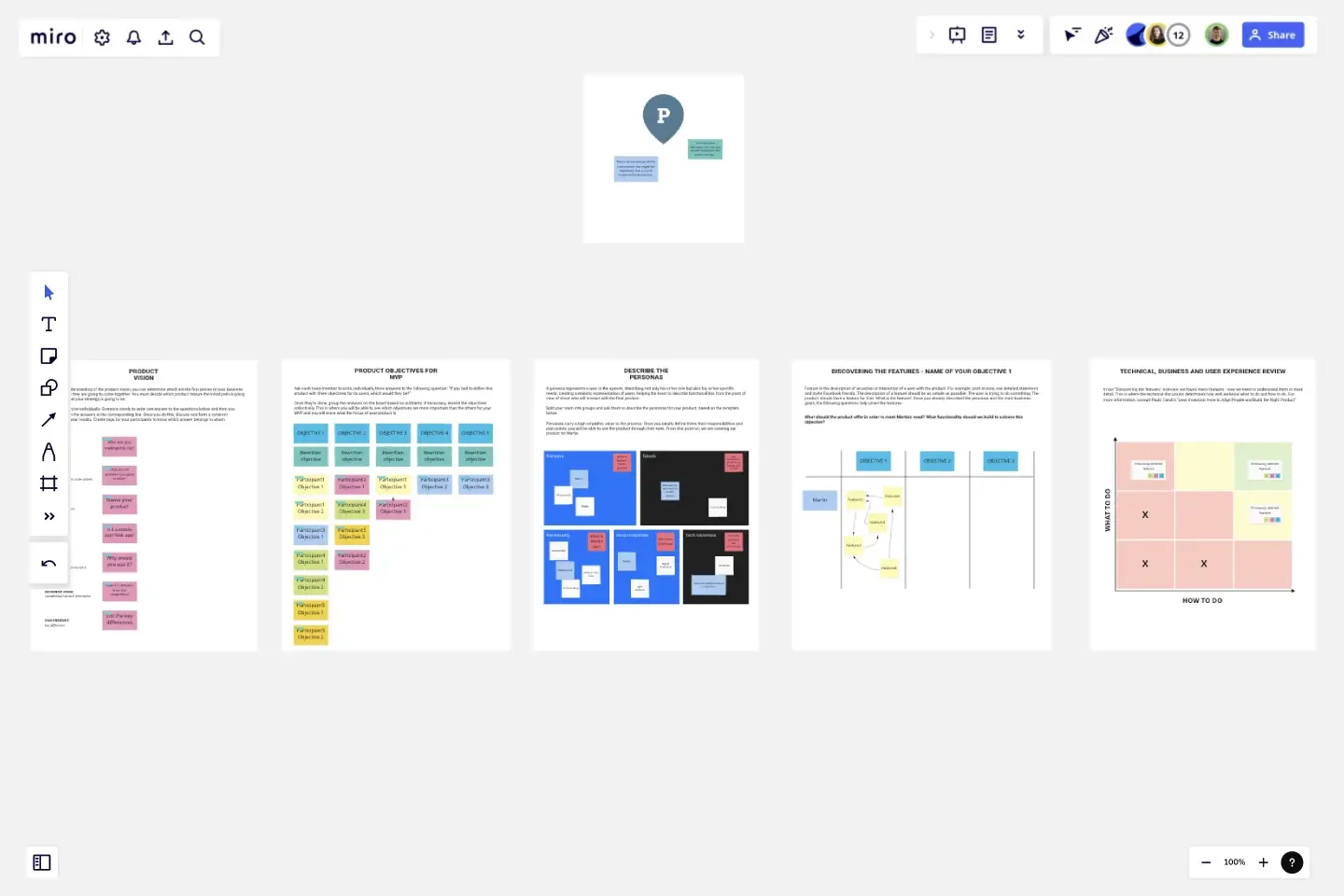Lean Inception
The Lean Inception method gives you a great place to start from - defining and developing an MVP.
Why use Lean Inception?
When we go into our workshops, we’re often faced with very little information and several stakeholders with different priorities and ideas about what needs to be done. It’s not possible to immediately make everyone happy, so our process helps us create a constructive dialogue between members of the same team who come into the workshop with different needs.
Through compromise and facilitated discussions, it gives us all a common goal to work towards and levels out everyone's expectations. This board is our interpretation of the Lean Inception approach and represents our learned experiences so far. We use it as a base and continue to modify it based on each workshop's needs. It helps us define the problem in the best possible way and get to a clearly defined MVP.
How is Lean Inception different from a Design Sprint?
We were interested in the problem-solving approach in the Design Sprint and the Lean Inception. The methodology was based on so much real experience from their creators that we wanted to give it a shot.
The Design Sprint method solves a different kind of issue than the Lean Inception one. The questions are different, as is the end result. As we went through them, we realized that the demands coming from our clients wouldn’t really fit either method - but a combination of both worked like a charm. Sometimes we also need to adapt the length of the workshop. We don't always have the 5 days both methodologies ask for - so we make it work in 3 days by cutting some of the activities. It's a bit more intense but works well both for our clients and us.
For example, we normally don't need to calculate the effort, time and cost - we try to go into the workshop with a ballpark figure regarding these estimates. However, this is an individual approach that works well for us, as we are in charge of both facilitating and developing the MVP in question.
The Lean Inception method gives you a great place to start from - defining and developing an MVP. This was most of what we needed to do. But in the end, it leaves you without a visual idea of what needs to be done. We feel that the visual representation of the problem being solved is like the cherry on top of a well defined MVP. That is where you can see that everyone is on the same page and you all understand the MVP properly. So we borrow the sketching part of the Design Sprint and incorporate it into our approach.
This template was created by RUBICON.
Get started with this template right now.
Lean Inception Workshop
Works best for:
Agile, Lean Methodology
The Lean Inception Workshop streamlines project kickoff by aligning teams on goals, scope, and priorities. It leverages Lean principles to eliminate waste and maximize value, guiding exercises to define user personas, map user journeys, and prioritize features. By fostering cross-functional collaboration and customer-centric thinking, this template accelerates project initiation and ensures alignment between stakeholders, empowering teams to deliver customer value faster.
Learning Loop Retro Template
Works best for:
Retros, Agile
The Learning Loop Retro template is a powerful tool designed to help teams reflect on their projects by recognizing successes and identifying areas for improvement. This template is part of Miro's Intelligent templates, which streamline workflows and keep teams engaged by integrating AI, interactive tools, and seamless integrations. One key benefit of the Learning Loop Retro template is its ability to drive continuous improvement. By regularly reflecting on their work and identifying areas for enhancement, teams can consistently elevate their performance and achieve better outcomes.
OKR Drafting Board
Works best for:
Agile
The OKR Drafting Board (New) is a visual tool for defining and tracking Objectives and Key Results (OKRs). It provides a structured framework for setting ambitious goals, defining measurable outcomes, and aligning teams around shared objectives. This template enables organizations to articulate their strategic priorities, track progress transparently, and foster accountability and alignment across teams. By promoting focus, alignment, and agility, the OKR Drafting Board empowers organizations to achieve breakthrough results and drive continuous improvement.
Scrum Compass
Works best for:
Agile, Meetings, Workshops
The Scrum Compass is a visual tool for guiding Scrum teams through their journey. It provides a structured framework for understanding Scrum roles, events, artifacts, and values. This template offers a comprehensive overview of Scrum principles and practices, enabling teams to align on common goals, roles, and processes. By promoting clarity and alignment, the Scrum Compass empowers teams to navigate the complexities of Agile development and deliver value with confidence and efficiency.
SIPOC Process Map
Works best for:
Agile Metodology
The SIPOC Process Map is a visual tool for documenting the high-level process flow of a system or project. It helps teams identify Suppliers, Inputs, Processes, Outputs, and Customers, facilitating a holistic understanding of the value stream. This template enables teams to visualize key process elements and interdependencies, empowering them to identify areas for improvement and optimize workflow efficiency. By promoting transparency and collaboration, the SIPOC Process Map empowers organizations to deliver value more effectively and satisfy customer needs.
Hiring Process Template
Works best for:
Operations, Org Charts, Kanban Boards
Having a hiring process in place simplifies that process each step of the way, from recruiting for the position to making finalizing offers. This simple, effective template will give you a straightforward, high-level view of where employees are as they move from applicant to new hire.
